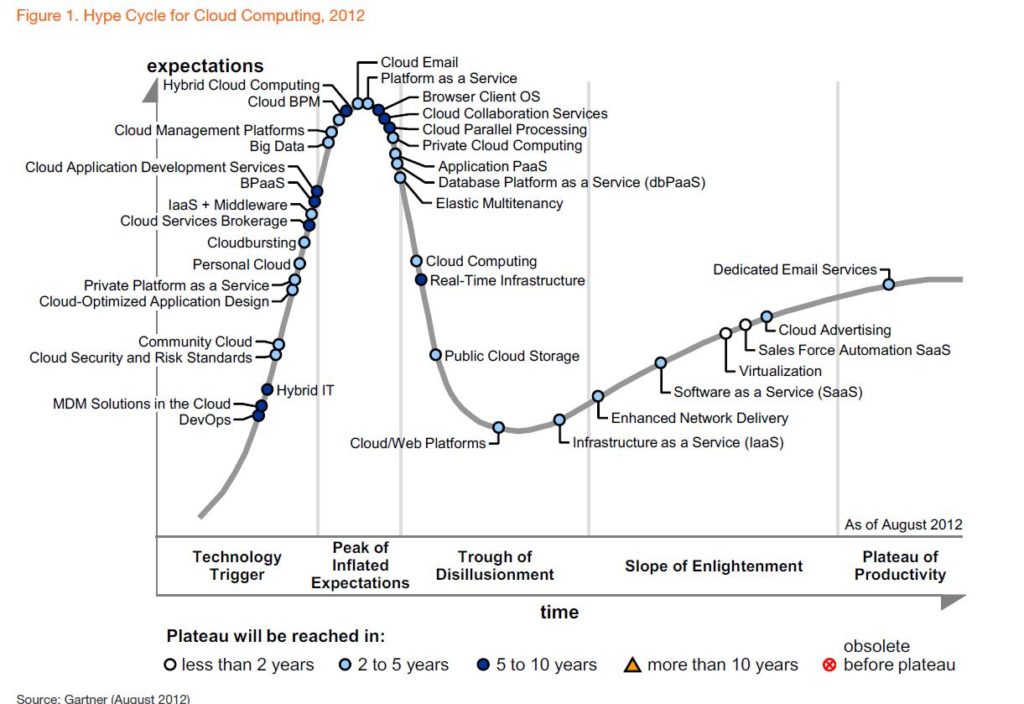Back in late-2007 I started a journey. I was brought into a company which rented out bare metal servers. Racking and stacking was their bread and butter, charging for space in a data center, leasing hardware and managing physical infrastructure. Hired as a Technology Evangelist, I wasn’t employed to spread the gospel of the tangible world, but rather to educate about something new, something called “cloud computing” – perhaps you have heard of it? And just a year earlier, a company that sold books and other products launched a series of services which would revolutionize computing, storage and infrastructure. Yes, that would be Amazon.

Cloud, back then, was new. It was a peek into what now is a staple, dare I say, a commodity. Infrastructure on demand that was scalable and billed by usage was something unheard of. Sure, virtualization technologies existed but frequently those instances were contained within private data centers or on people’s personal computers. Companies large and small began to pay attention. There was a lot of hype, fear, uncertainty, distrust – the things fairly typical to anything “new.” Concerns over stability and security, which are still concerns even today, frequently overshadowed the potential of this new IT change agent. IT executives struggled to not only understand this movement but also how to control it. Armed with just a credit card, developers had the ability to spin up infrastructure ad hoc. As I said, it was revolutionary.
But it was also evolutionary.
People always champion Darwin’s concept of survival of the fittest. With the introduction of cloud computing, companies suddenly had the ability to evolve differently – to adapt the best characteristics of the cloud and fold it into their own developing business and technology strategies.
Clouds are Cloudy and Complex
But there was (and actually still is) a problem. This evolution, I have discovered, is bumpy. Despite the efforts of me and my colleagues, businesses, the media, marketing and sales organizations and the even members of public in at large, there was a misperception of what cloud was or what it could do. And honestly, this confusion still exists. It was and continues to be a journey of education, information sharing, collaboration, invention and risk.

After 6 years of championing the cloud, I stepped away for a few years. At that point, 2013, I did feel there was less fear and fewer misperceptions, and more adoption and innovation – by companies using the cloud AND by the cloud providers themselves. In 2012, Gartner showed Cloud Computing as being well beyond the Technology Trigger and Peak of Inflated Expectations and even moving quickly through the Trough of Disillusionment. By 2013, businesses were becoming “enlightened” by the possibilities.
It’s now the end of 2016 and it is incredible to me how this IT evolution has progressed. Cloud is established. Business niches have been formed. Start-ups and established providers are innovating at break-neck speeds. And if a company doesn’t have some sort of a cloud strategy, it is losing its competitive advantage or edge.
It’s Still About Education
But the issue of education still persists. It could be due to increased IT complexity or the number of players in the space or legacy IT mixed with the next “bright and shiny” thing.

As of this writing, I will have completed about a month at Riverbed. And I’m honestly shocked to find out how little I now know about cloud and the surrounding ecosystems. It’s been only three years but as we all know, a year in the technology space is multiple in the real world. And I wonder, if I’m scratching my head, how are business and IT leaders faring?
I offer this advice. The solution is in learning and education, talking with your peers, reading trade journals, engaging in discussions, getting POCs and demos from solution providers, and asking lots and lots of questions. Over the past few weeks, I have been doing just that. And the changes from the dawn of cloud and present day innovations are significant, so much so I thought I would note a few of them here.
A Learning Moment
Here are just a few things I have recently discovered which perhaps can help those trepidatiously testing the waters:
- “Digital Transformation” has replaced the “cloud” buzzword – This actually was a new buzzword I had to quickly learn and interpret. Also known affectionately now as “DX,” it’s appearing on presentations in boardrooms and in emails throughout modern business. While probably the subject of an article on its own, it represents the adoption of cloud, the integration of disparate IT systems (physical, on-premise, virtualized and in private/public clouds) and the evolution to a holistic view and management of all. But it is more than this, as it is coupled with businesses leveraging these technologies into their own business practices, models and processes.
- It’s not about shifting CapEx to OpEx anymore – While back in 2007 I was touting how companies no longer had to purchase infrastructure and how they could move expense to operations, now this is no longer the case. Yes, the cloud, for example, does offer a much better means to control IT spend and lower that percentage of unused IT resources – I have learned that there is a much better story now. Optimizing your resources, applications, networks and connected infrastructure can actually reduceboth CapEx AND OpEx. Searching for buggy code manually or programming networking devices via CLI is time consuming and error-prone, and all increase OpEx. Using a software-defined approach can both automate and standardize manual processes of the past. And gaining visibility can reduce the problem of Shadow IT.
- IT has become even more complex – It’s not just compute and storage anymore, it’s network and application performance, unified communications, SaaS optimization (think Office365 – read Steve Brar’s discussion on optimizing the end-user experience for Office 365), legacy integration, and much, much more.
- To be successful, you must have granular insights – Application and network performance monitoring has matured to the point where I have learned that you cannot simply analyze summaries or roll-ups of data points; you must look at each and every point to view hidden patterns. Jon Hodgson has a fascinating presentation that outlines the importance of data-point analytics. Case in point, at around 28 minutes into the video, the scatter-charts he discusses are eye-opening. But watch the whole video and then think about how your organization does analytics.
- Don’t ignore “living on the edge” – Improving capabilities of all tendrils of organizations, from headquarters to data centers to branch offices to remote workers – all should be empowered by finely-tuned, closely-monitored and analyzed, and well-optimized IT. And deployments of branch office IT should take hours and not days or weeks, as Alison Conigilaro Hubbard outlines in her explanation of modernizing Edge IT.
- Forgetting the network means disaster – While compute and storage continue to advance, so does the network. But often, businesses neglect this aspect of IT. Bandaging old routing hardware into private and public networks without defining which protocols or apps should traverse one over the other can cause a hemorrhage within a dispersed infrastructure. Dedicating confidential data transfers via an MPLS link seems obvious enough but would SharePoint traffic benefit by following the same route? Probably not, as Mason Coffman outlines. And this is where software-defined wide area networking (SD-WAN)
Digital Transformation is a journey, not only of research, implementation and usage, but also of education. Perhaps like me, you are a student. Or maybe a teacher. Regardless, it is through conversation and the exchange of ideas that individuals and businesses can grow and succeed.
But what I really want to know is, what have you seen to be transformational over the past few years within IT? What is revolutionary? What is evolutionary? What has become commoditized and where is the next innovation coming from?
HTD says: We’ve entered the stratosphere of IT — connecting clouds with terra firma and everything else in between. And whether you are a pilot or a passenger on this journey, we are all in it together.




4 comments
Jeff Sweet
I’m also interested to know how your opinion has shifted now that you’re working for a company that sells a product vs infrastructure. How are they reinventing themselves? Are they taking a cloud first approach to their products?
hightechdad
Thanks for the comments. It’s actually an interesting shift. I’m not sure I would exactly say it’s a shift from selling “infrastructure” as when you think about networking, that is a core component to infrastructure (the glue that binds it all together in some ways). And, since some of our offerings at Riverbed are software-based (e.g., SD-WAN), can we not consider that to be infrastructure-related AND cloud? In fact, we have/are virtualizing appliances to be deployed and managed, to act much the same way a physical appliance works. It’s quite interesting. Yes there is a focus on cloud-enablement and being cloud-ready, but as you know, enterprises have a mixture of infrastructure now, cloud being one of them. But couple that with data centers, legacy hardware, edge appliances/offices/branch, etc. and you can see how complex it can be. Cloud is just one part of the equation in my opinion. It’s not really an re-invention, but more of an expansion of capabilities to embrace the digital transformation to be able to work with all types of infrastructure, cloud or not.
Jeff Sweet
Edge computing has a lot of interest to me. IoT comes up a lot, but IoT at the Edge seems to enter in the discussion.
Revolutionary to me is Serverless computing. AWS Lambda has started quite a movement, look up the company Serverless, they recently just received an investment.
hightechdad
It actually funny and timely that you bring up Edge computing (or as some people say “Fog Computing”). I’m learning about this concept and have some questions into the some of the folks way smarter than me here at Riverbed to get their read. One of the powerful and compelling features of our products is actually pulling the data away from the edge and centralizing it so that it can be optimized. When something on the edge requests a data object that has changed, for example, only the changed bits are sent, optimizing performance and speed. Edge seem to be contrary to this but again, I don’t know enough about it. There may be ways we are optimizing for Edge Computing. It’s something that I’m investigating. IoT is a core part (like Cloud) and those IoT devices have a different way of managing data. Great questions!
I will definitely take a look at Lambda. As we are AWS partners, I’m sure there is something in the works but again, I don’t have the insight (yet) to comment on this.